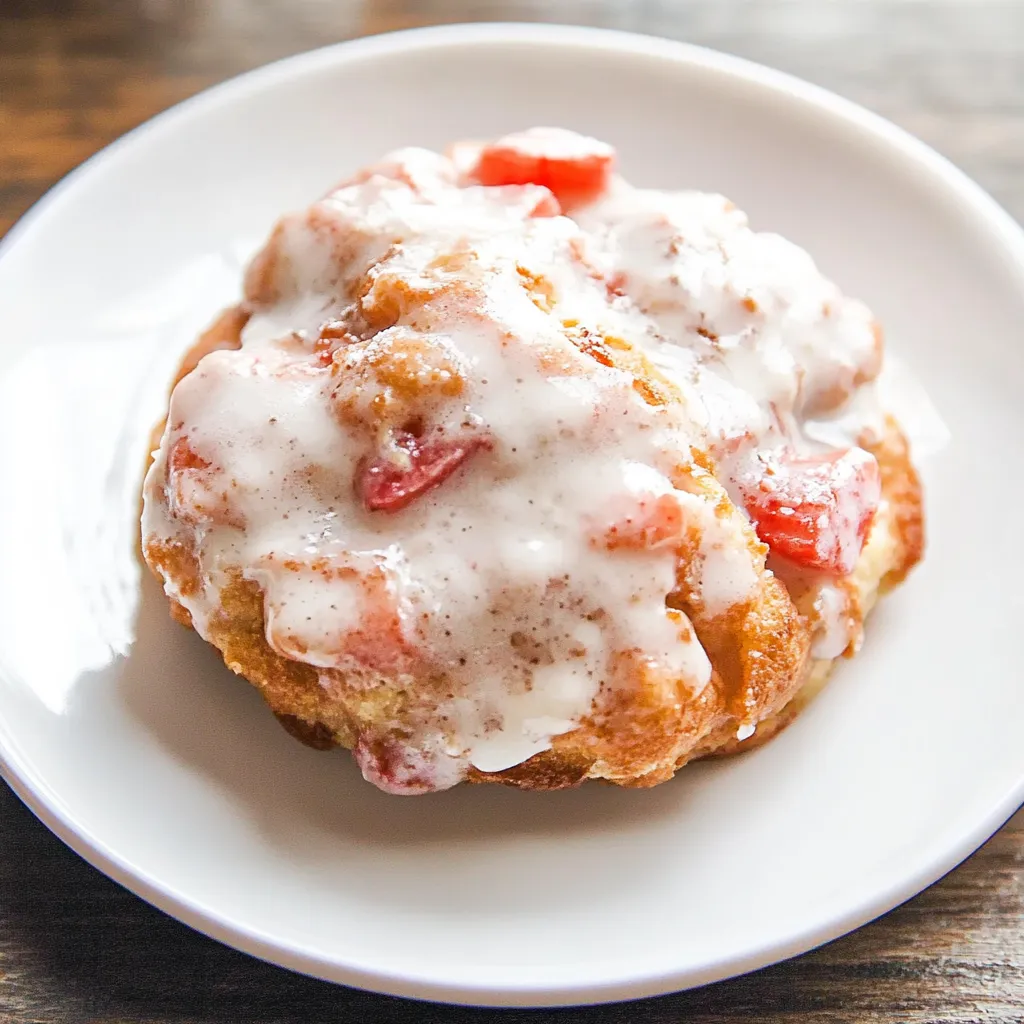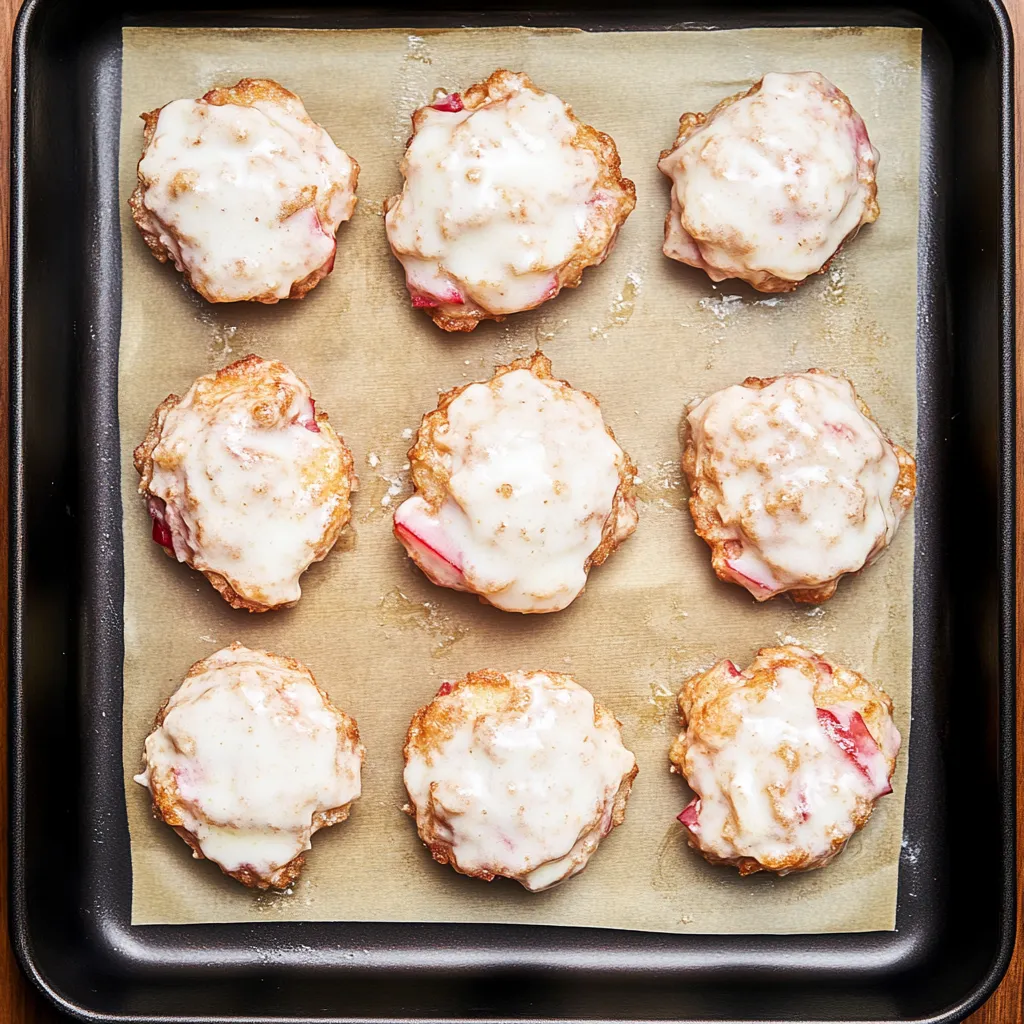 Pin it
Pin it
These incredible rhubarb fritters transform tart, fresh rhubarb into pillowy, golden-brown treats that are part donut, part fruit pastry, and entirely irresistible with their sweet, tangy glaze made from the rhubarb's own juices. The yeasty dough creates a tender, airy texture that perfectly balances the chunks of macerated rhubarb, while a hint of cardamom adds aromatic warmth that elevates these from simple fried dough to something truly special. Unlike quick fritter batters that can be dense or greasy, this yeasted dough approach creates light, fluffy results with complex flavor that develops during the rising process, making these fritters worthy of a special weekend project.
I discovered this recipe when I wanted to create something special with the abundance of rhubarb from my neighbor's garden, and I was amazed at how the yeasted dough technique created such light, complex-flavored results. The first time I served these for a weekend brunch, guests couldn't stop talking about the unique combination of textures and how the rhubarb glaze tied everything together so beautifully.
Essential Ingredients and Selection Tips
- Fresh rhubarb: Choose firm, crisp stalks with good color; avoid any that are limp, stringy, or have brown spots
- All-purpose flour: Medium protein flour provides the right balance of structure and tenderness for the dough
- Instant yeast: This creates slower, more controlled rising that develops better flavor than rapid-rise varieties
- Fresh buttermilk: The acidity tenderizes the dough while adding tangy flavor that complements the rhubarb
- Ground cardamom: Use freshly ground if possible for the most aromatic, complex flavor; pre-ground works but won't be as vibrant
- Neutral frying oil: Choose oils with high smoke points like canola or vegetable oil for safe, clean frying
The secret to perfect fritters is embracing their rustic nature - they're meant to be irregularly shaped and beautifully imperfect, so don't worry about making them look uniform or pristine.
Detailed Step-by-Step Instructions
- Step 1: Prepare the rhubarb:
- Wash and trim the rhubarb stalks, then cut into ½-inch pieces. Toss the chopped rhubarb with 2 tablespoons of sugar in a bowl and let macerate for 1 hour - this draws out the natural juices that will become your glaze. Drain the rhubarb, reserving every drop of the precious pink juice for later.
- Step 2: Make the dough base:
- In a large mixing bowl, whisk together the warm buttermilk, melted butter, egg, and instant yeast until well combined. The mixture should be pleasantly warm but not hot enough to kill the yeast.
- Step 3: Form the dough:
- Add the flour, remaining sugar, baking soda, cardamom, and salt to the wet ingredients. Mix until a shaggy dough forms, then turn onto a lightly floured surface and knead for 5-8 minutes until smooth and elastic but still slightly sticky.
- Step 4: First rise:
- Place the dough in a greased bowl, cover with a damp towel, and let rise in a warm place for 1-2 hours until doubled in size. The dough should feel light and airy when properly risen.
- Step 5: Incorporate the rhubarb:
- On a lightly floured surface, roll the risen dough into a rectangle about 12x8 inches. Distribute the drained rhubarb pieces evenly over the dough, then fold the dough over the fruit and gently knead just enough to distribute the rhubarb throughout - don't worry if some pieces fall out.
- Step 6: Shape the fritters:
- Divide the dough into 12 roughly equal portions. Shape each piece into an oval, gently pressing any loose rhubarb pieces back into the dough. The fritters should look rustic and uneven - this is exactly what you want.
- Step 7: Prepare for frying:
- Heat oil to 350°F in a heavy pot or deep fryer. While the oil heats, make the glaze by whisking the reserved rhubarb juice with powdered sugar until smooth. Adjust consistency with more juice or sugar as needed.
- Step 8: Fry to golden perfection:
- Carefully lower 3-4 fritters into the hot oil, being careful not to overcrowd. Fry for 2-3 minutes per side until deep golden brown and puffed. The fritters will look messy going in but will puff up beautifully and hold together.
- Step 9: Drain and glaze:
- Remove fritters to a wire rack placed over parchment paper to catch drips. While still warm, dip each fritter into the rhubarb glaze, allowing excess to drip off before placing back on the rack.
- Step 10: Serve immediately:
- These fritters are absolutely best enjoyed while still warm and the glaze is just set. The contrast between the warm, pillowy dough and the sweet-tart glaze is at its peak when fresh.
 Pin it
Pin it
The most important technique is not overthinking the shaping process - fritters are meant to be rustic and imperfect, and trying to make them too neat will result in dense, overworked dough.
These rhubarb fritters have become my favorite example of how traditional baking techniques can transform humble ingredients into something truly special and memorable. My kids initially weren't sure about "vegetable donuts," but after one bite they were completely converted and now request these every time we have fresh rhubarb.
Understanding Yeast Fermentation and Flavor Development
The yeasted dough approach creates superior flavor and texture compared to quick fritter batters because fermentation develops complex flavors while creating the light, airy structure that makes these fritters so appealing. The slower rise allows enzymes to work on flour proteins and starches, creating more interesting flavors than simple chemical leavening. The combination of yeast and baking soda provides both slow flavor development and quick lift when the dough hits the hot oil, creating optimal texture.
Oil Temperature and Frying Science
Maintaining proper oil temperature is crucial for fritters that are crispy outside and fully cooked inside without being greasy. At 350°F, the exterior sets quickly, preventing oil absorption while allowing heat to penetrate and cook the interior thoroughly. Lower temperatures result in greasy, oil-soaked fritters, while higher temperatures burn the outside before the inside cooks. The irregular shape of fritters means cooking times vary slightly, making visual cues important for determining doneness.
Fruit Integration and Moisture Management
Incorporating fresh fruit into yeasted dough requires understanding how moisture affects both texture and structure. Macerating the rhubarb removes excess water that could make the dough soggy while concentrating flavors. The folding technique distributes fruit without overworking the dough, which could develop gluten excessively and create tough results. The fruit pieces may seem like they'll fall out, but the dough's elasticity and the frying process create enough structure to hold everything together.
Glaze Chemistry and Application
The rhubarb juice glaze works because the natural fruit acids and sugars create a coating that sets as it cools while providing intense flavor that complements the mild dough. The timing of glazing is important - too hot and the glaze slides off, too cool and it doesn't adhere properly. The consistency should be thick enough to coat but thin enough to penetrate slightly into the surface, creating both visual appeal and flavor penetration.
Storage and Quality Maintenance
Yeasted fritters are best consumed fresh because their light texture and moisture content make them prone to staling quickly. The combination of oil, sugar, and fruit creates an environment where texture degrades rapidly. Proper cooling on wire racks prevents sogginess from trapped steam, while room temperature storage for short periods maintains the best texture. Freezing before glazing preserves quality better than storing completed fritters.
These rhubarb fritters have taught me that some of the most memorable baked goods come from embracing imperfection and rustic charm rather than pursuing flawless technique. Every time I make them, I'm reminded that food made with love and enthusiasm often tastes better than technically perfect items made without soul, proving that baking is as much about joy and creativity as it is about precision.
Frequently Asked Questions
- → Can I use frozen rhubarb instead of fresh?
- Yes, but thaw and drain the rhubarb first. Fresh rhubarb gives better texture and more juice for the glaze.
- → How do I know when the oil is hot enough?
- Use a thermometer to reach 350°F, or test with a small piece of dough - it should sizzle and float immediately.
- → Can I make the dough ahead of time?
- Yes, you can refrigerate the dough after the first rise for up to 24 hours. Let it come to room temperature before shaping.
- → What if I don't have cardamom?
- You can skip the cardamom or substitute with cinnamon, though cardamom gives a unique flavor that pairs well with rhubarb.
- → How long do these fritters stay fresh?
- Best eaten within 2-3 hours of frying while still crispy. Store leftovers covered at room temperature for up to 2 days.
- → Can I bake these instead of frying?
- Frying gives the best texture, but you can bake at 375°F for 15-20 minutes. They won't be as crispy but still tasty.
